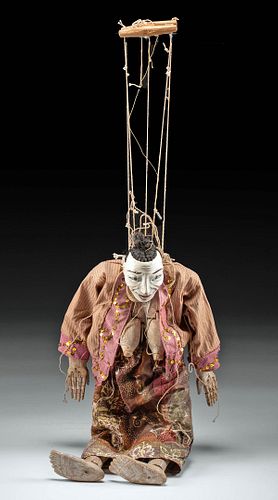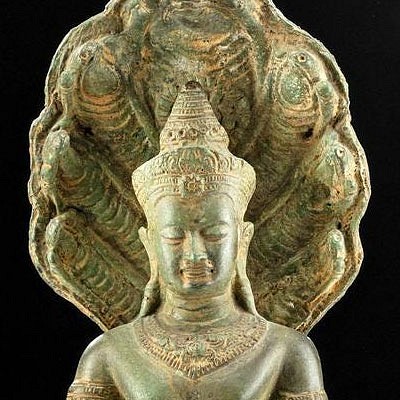Early 20th C. Japanese Articulated Wood Marionette
Lot 35
About Seller
Artemis Gallery
686 S Taylor Ave, Ste 106
Louisville, CO 80027
United States
Selling antiquities, ancient and ethnographic art online since 1993, Artemis Gallery specializes in Classical Antiquities (Egyptian, Greek, Roman, Near Eastern), Asian, Pre-Columbian, African / Tribal / Oceanographic art. Our extensive inventory includes pottery, stone, metal, wood, glass and textil...Read more
Categories
Estimate:
$400 - $600
Absentee vs Live bid
Two ways to bid:
- Leave a max absentee bid and the platform will bid on your behalf up to your maximum bid during the live auction.
- Bid live during the auction and your bids will be submitted real-time to the auctioneer.
Bid Increments
| Price | Bid Increment |
|---|---|
| $0 | $25 |
| $300 | $50 |
| $1,000 | $100 |
| $2,000 | $250 |
| $5,000 | $500 |
| $10,000 | $1,000 |
| $20,000 | $2,500 |
| $50,000 | $5,000 |
| $100,000 | $10,000 |
| $200,000 | $20,000 |
About Auction
By Artemis Gallery
Aug 10, 2021
Set Reminder
2021-08-10 12:00:00
2021-08-10 12:00:00
America/New_York
Bidsquare
Bidsquare : Museum-Deaccession | Asian & Pre-Columbian
https://www.bidsquare.com/auctions/artemis-gallery/museum-deaccession-asian-pre-columbian-7316
An interesting mix of de-accessioned Asian and Pre-Columbian Art from The Ashland University Museum in Ashland, OH, originally donated between 1994 to 1998. All lots from the Museum have been noted, as such. Artemis Gallery info@artemisgallery.com
An interesting mix of de-accessioned Asian and Pre-Columbian Art from The Ashland University Museum in Ashland, OH, originally donated between 1994 to 1998. All lots from the Museum have been noted, as such. Artemis Gallery info@artemisgallery.com
- Lot Description
East Asia, Japan, ca. early to mid-20th century CE. A wonderful carved-wood marionette dressed in a tunic and skirt of silken cloth. The intriguing figure displays a long body and jointed arms and legs with intricately delineated fingers and toes, all attached to marionette strings. A pair of drooping breasts protrude from the figure's square torso, featuring large nipples that are also attached to strings. Hand-painted white with black, red, and pink details, her expressive visage presents triangular eyes beneath straight brows, a naturalistic nose, high cheek bones, and a smiling mouth with the ability to open and close, all capped with a black coiffure of horsehair tied into a top bun. Her tunic showcases shades of violet and puce with lustrous golden sequins, while her skirt exhibits a lovely floral pattern of russet, olive, sienna, puce, black, and white. Size: 25" arm span x 21" H (63.5 cm x 53.3 cm)
Bunraku is a Japanese traditional form of puppet theater. Puppeteers used doll-puppets to chant a dramatic narrative known as joruri with musical accompaniment on a samisen (three stringed lute). The term Bunraku comes from the name of a puppeteer troupe founded by Uemura Bunrakuken in the early 19th century. Several puppeteers are needed to operate each puppet. Traditionally, the primary handler dons 18th century attire and operates the puppet's head and right hand, moving eyes, eyebrows, lips, as well as fingers. A pair of assistants, dressed in black, in order to blend into the background and not detract from the puppets, operate the hands, legs, and feet. Extensive training is necessary in order to attain synchronized motion and lifelike gestures and emotions during the performance. UNESCO identified Bunraku as a Masterpiece of Oral and Intangible Heritage of Humanity in 2003.
Provenance: ex-Stein collection, Bloomfield Hills, Michigan, USA, acquired prior to 2010
All items legal to buy/sell under U.S. Statute covering cultural patrimony Code 2600, CHAPTER 14, and are guaranteed to be as described or your money back.
A Certificate of Authenticity will accompany all winning bids.
PLEASE NOTE: Due to recent increases of shipments being seized by Australian & German customs (even for items with pre-UNESCO provenance), we will no longer ship most antiquities and ancient Chinese art to Australia & Germany. For categories of items that are acceptable to ship to Australia or Germany, please contact us directly or work with your local customs brokerage firm.
Display stands not described as included/custom in the item description are for photography purposes only and will not be included with the item upon shipping.
#164350Nicks and abrasions throughout, commensurate with age and use. Otherwise, intact and excellent with lovely remaining pigments.Condition
- Shipping Info
-
All shipping is handled in-house for your convenience. Your invoice from Artemis Gallery will include shipping calculation instructions. If in doubt, please inquire BEFORE bidding for estimated shipping costs for individual items.
-
- Buyer's Premium



 EUR
EUR CAD
CAD AUD
AUD GBP
GBP MXN
MXN HKD
HKD CNY
CNY MYR
MYR SEK
SEK SGD
SGD CHF
CHF THB
THB













